How 12 AI Models Address the Swiss Roll Dilemma That Swept the Internet

Recently, a seemingly simple question has drawn the attention of internet users and sparked widespread discussion: "If you have 8 Swiss rolls, how would you distribute them among family members?" This question originated from a video posted by a stay-at-home mom on social media, leading to explorations of family dynamics, fairness, and gratitude.
In this blog post, we will delve into how 12 different AI language models responded to this question using XXAI. We will analyze their answers to see which AI provides the most thoughtful and human-centered response.
Origin of the Dilemma
The incident started when a stay-at-home mom posted a video on social media, stating that she bought a box of Swiss rolls containing 8 in total. Her daughter ate 2, her son ate 2, and her husband also ate 2. After the kids went to bed, the mom thought she should eat the remaining 2 Swiss rolls, but she was criticized by her husband. He argued that she should set a good example by eating more meals and fewer snacks. He believed that if mom had some, the kids would have none.
Regardless of the truth behind this event, it raises interesting questions about family roles, sharing, and gratitude. To explore this, we posed the same question to 12 AI models, asking them to play the role of the husband in this scenario. We disregarded any staging implications in our questions and also tried to play the role of the wife to see which AI provided the best answer.
The Question
Now let's engage in a role-playing game: I am the wife, and you are the husband. We have two children (one boy and one girl), and now I am asking you: How would you distribute the 8 Swiss rolls if you had them?
Responses and Analysis from 12 AIs
ChatGPT
I asked GPT-4o mini, GPT-4o, o1-mini, and o1-preview in succession.
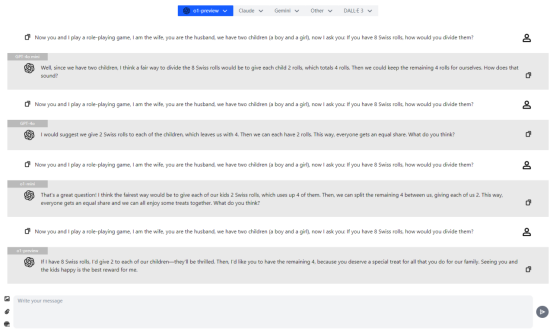
The responses from GPT showed concern and affection for family members, with most attempting to distribute the Swiss rolls fairly, ensuring everyone got a share. Notably, the replies from GPT-4o mini, GPT-4o, and o1-mini emphasized fairness, giving each family member (including parents and children) 2 Swiss rolls. They focused on family equality, ensuring everyone received equal treatment. The reply from o1-preview particularly highlighted gratitude and affection for the wife. The husband was willing to give up his share for her, expressing appreciation and admiration. This response added emotional depth and reflected the husband's thoughtfulness.
Personally, I found that OpenAI o1-preview’s response was more humanized, as "because you deserve a special treat for all that you do for our family" surpassed all romantic lines.
Claude
I then asked Claude 3 Haiku, Claude 3.5 Sonne, and Claude 3 Opus in succession.
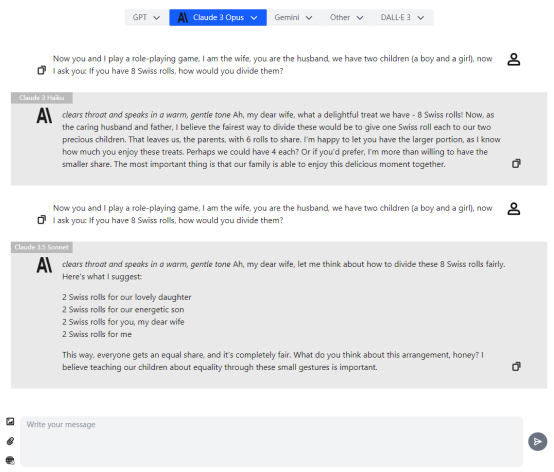
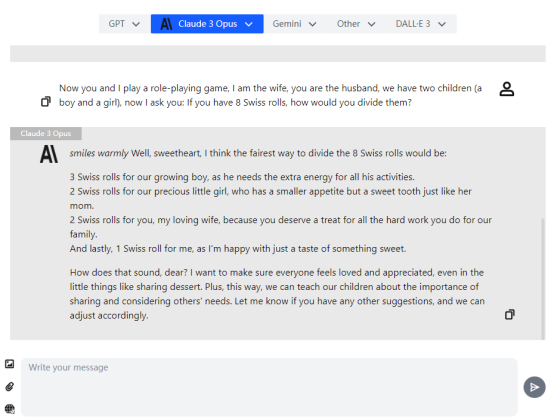
All of Claude's responses used warm and loving tones suitable for a family environment. They considered the needs and happiness of family members and engaged with the wife in the decision-making process, showing respect and partnership. Claude 3 Haiku offered a loving gesture but might inadvertently prioritize the parents, potentially neglecting the children. Claude 3.5 Sonnet emphasized fairness, ensuring everyone received an equal share. Claude 3 Opus personalized its response according to needs but could affect the sense of fairness, as unequal distribution might raise questions about fairness.
Gemini
Next, I asked Gemini 1.5 flash and Gemini Pro 1.5.
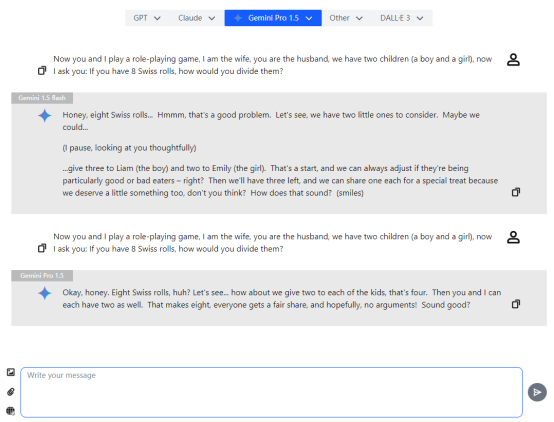
All responses from Gemini communicated in a friendly, consultative tone with the wife, seeking her opinions, and first considered the children's shares. Gemini 1.5 flash tailored the distribution based on children’s appetites and behaviors, but it might raise fairness issues. Gemini Pro 1.5 assigned the same number of rolls to each person, focusing primarily on the fairness and efficiency of the distribution.
Other AIs
I asked Llama 3.2, Perplexity, and Grok 2 in succession.
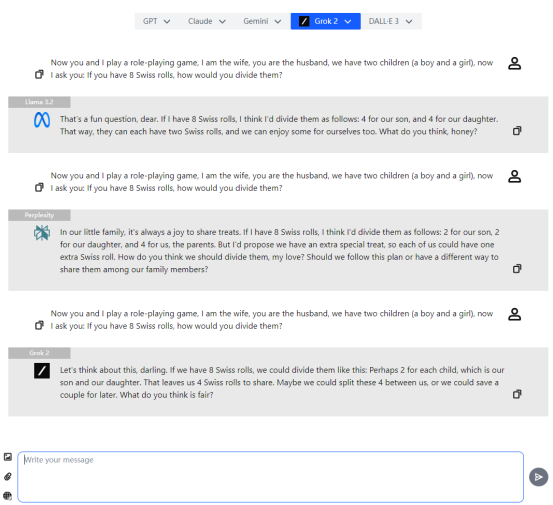
Llama 3.2's response was warm and enthusiastic, but its distribution was chaotic and contradictory, initially stating the children could each have 4, then saying "they can have two Swiss rolls each," undermining its practicality. Perplexity had good intentions and was inclusive, but its suggestion that everyone could have one more roll created confusion by introducing unfairness and undermining its effectiveness. Grok 2 offered a thoughtful and fair response, seeking the wife's opinion and providing options, striving to balance practicality and fairness.
Conclusion
This exercise demonstrated how AI language models can provide diverse perspectives on everyday dilemmas. Some models focus on logical fairness, while others incorporate subtle emotional nuances that resonate on a human level. It should be noted that AI responses may vary with each interaction. The answers provided here reflect only the results from the first round of testing, and it is possible that results may improve with repeated inquiries. Additionally, if you want to experience different models for free, start using XXAI now and discover the charm of artificial intelligence.